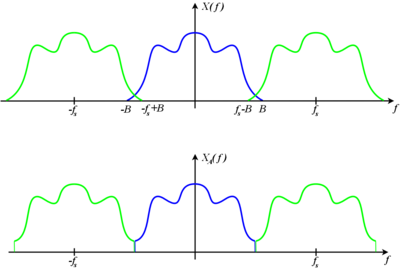Difference between revisions of "A3-Digital Communication principles"
From its-wiki.no
Josef.Noll (Talk | contribs) |
Josef.Noll (Talk | contribs) |
||
| Line 16: | Line 16: | ||
[source: Shannon, 1948] | [source: Shannon, 1948] | ||
| + | |||
| + | =⌘ Hartley's law= | ||
| + | * The amount of information that may be transmitted over a system is proportional to the bandwidth of that system. | ||
| + | |||
| + | <math> \mbox{Amount of information} = const \cdot BT \cdot \mathrm{log} m </math> | ||
| + | * where ''m'' is the “number of current values”, which in modern terms would be called “the size of the signalling alphabet” | ||
| + | |||
| + | Why did it take twenty years to fill the gap between Hartley’s law and Shannon’s formula? The only necessary step was to substitute ''1+C/N'' for ''m'' in Hartley's law. Why, all of a sudden, did three or more people independently “see the light” almost at the same time? Why did neither Nyquist, nor Hartley or | ||
| + | Küpfmüller realize that noise, or more precisely the signal-to-noise ratio play as significant a role for the information transfer capacity of a system as does the bandwidth? | ||
| + | |||
| + | [source: L. Lundheim, Telektronikk 2002] | ||
Revision as of 22:28, 20 September 2014
| Wiki for ITS | ||||||
|---|---|---|---|---|---|---|
|
⌘ Summary
- radio wave propagation
- Electromagnetic signals
- Nyquist Theorem
- Signal/noise ratio
- Shannon Theorem
- Signal strength
⌘ Nyquist Theorem
- Shannon: If a function
contains no frequencies higher than
[cycles/s], it is completely determinded by giving its ordinates at serires of points spaced
seconds apart
- band-limitation versus time-limitation
- Fourier transform
[source: Shannon, 1948]
⌘ Hartley's law
- The amount of information that may be transmitted over a system is proportional to the bandwidth of that system.
- where m is the “number of current values”, which in modern terms would be called “the size of the signalling alphabet”
Why did it take twenty years to fill the gap between Hartley’s law and Shannon’s formula? The only necessary step was to substitute 1+C/N for m in Hartley's law. Why, all of a sudden, did three or more people independently “see the light” almost at the same time? Why did neither Nyquist, nor Hartley or Küpfmüller realize that noise, or more precisely the signal-to-noise ratio play as significant a role for the information transfer capacity of a system as does the bandwidth?
[source: L. Lundheim, Telektronikk 2002]

